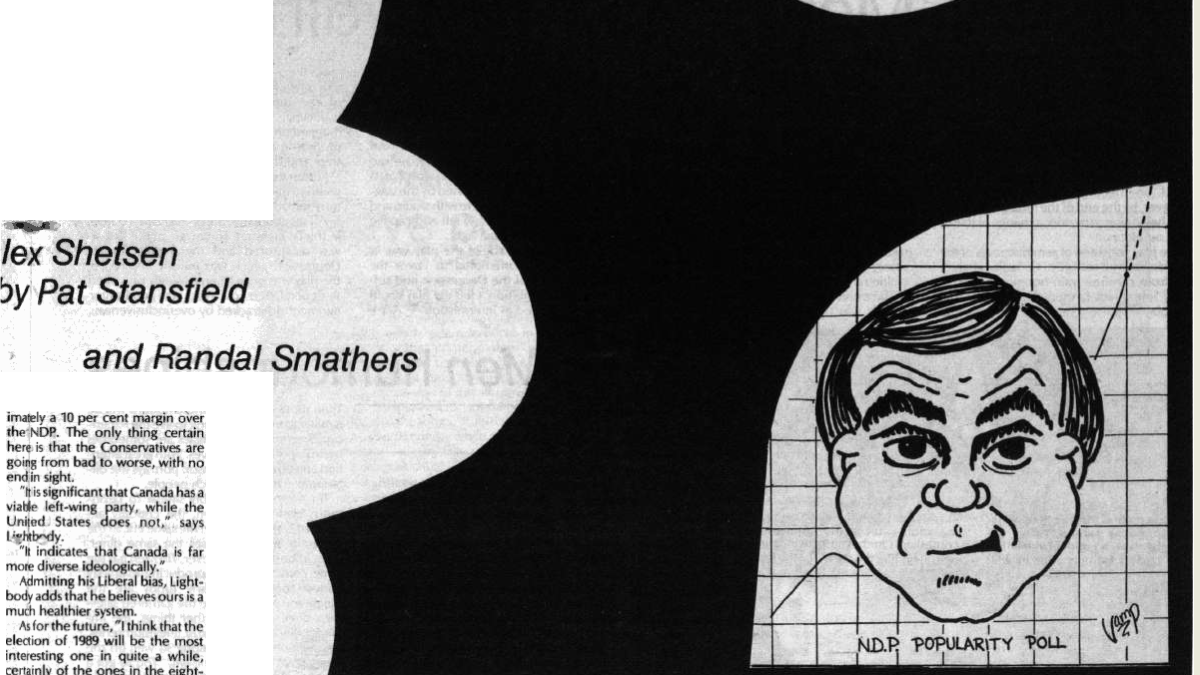Throwback: NDP popularity – Has it passed its peak or is it permanent?
 Bruce Peel Archives
Bruce Peel ArchivesMarch 31, 1987
Alex Shetsen
We are at an interesting point in Canadian political history. While the governing Conservatives continue to self-destruct in the opinion polls, the New Democratic Party shows astonishing growth in its popularity.
Support for the NDP seems to have risen so much in the last year that the question naturally rises: why? And furthermore, to what end?
Will the federal NDP form the official opposition after the 1989 election, or (even more titillating) will they win it?
Almost forgotten in the rush of excitement are the Liberals, who nevertheless lead the opinion polls right now.
The Gateway spoke to the U of A’s James Lightbody about the NDP’s rise. Lightbody’s name is quite familiar: besides being Professor of Political Science at the university, he often appears in the newspapers as a prominent Liberal party spokesman.
Though at times admitting a Liberal leaning, Lightbody’s comments give an interesting look at the NDP’s past, its present, and possible future.
Socialism in its many forms is nothing new to Canada. As early as 1909, the official opposition in British Columbia was the Social Revolutionary party. However, the roots of the modern movement began in 1921.
That year, three groups appeared on the federal political scene: the Independent Labour Party; the Progressives, a national version of the United Farmers who in 1921 won the Alberta elections; and the League for Social Reconstruction, a more theoretically-oriented party of intellectuals, artists, and the like.
The Progressives were the most popular of the three parties: they won 64 parliamentary seats in 1921, beating the Conservatives who only had 50. By 1926, however, there were no Progressive MPs in Canada.
In 1933, the three groups merged to become the Canadian Co-operative Federation (CCF). Since then, the CCF (which changed its name to the New Democratic Party in 1962) has been Canada’s “third party.” Its fortunes have risen and fallen, (Diefenbaker’s Conservative landslide of 1958 reduced the CCF to 8 seats federally), but in general, the CCF/NDP has taken 15-30 seats in Parliament each election.
Provincially the CCF/NDP has seen power, especially in the West. It has been most popular in Saskatchewan, where Tommy Douglas (one of the movement’s founders and its most memorable character) and his successors W.S. Lloyd and Alan Blakeney ruled with only minor interruptions between 1944 and 1982.
There have also been NDP governments in Manitoba (Edward Shryer 1969-77 and Howard Pawley 1981-), and British Columbia (David Barrett 1972-75). Finally, the New Democrats have been the official opposition in Alberta since 1982.
What is most remarkable, then, is how much the NDP has gained in the opinion polls nationally. It has reached 34 per cent and is now tied in with the Liberals (44 per cent of the adult vote) in the popularity contest in Quebec, a province in whose politics the party, for the last half-century, has not been a major factor.
Polls have shown that the NDP’s popularity has also risen in other provinces. What is to explain this rise?
Lightbody believes that it is still too early to account for the NDP’s rise in the pols and to decide how permanent its popularity is. Therefore, he said, the next federal election, in 1988 or 1989, will be crucial in determining the balance of Canada’s three parties. “We are all looking forward to see whether 1989 will be a realigning election.”
“The Conservatives are just continuing to blunder around,” says Lightbody. At the same time, he adds, there is a perception that Liberal leader John Turner has not been in touch with the country: “a lot of people think he relies too much on his advisors in Toronto.” (It should be remembered, on the other hand, that Turner is the only federal party leader with a western seat in Parliament — Vancouver Quadra.)
Thus, with every poll, the NDP’s rating waxes. Lightbody is unsure, however, how permanent or stable the growth is.
On the one hand, NDP policies may well be best-suited to today’s conditions. Despite an economic boom in Southern Ontario, much of Canada, especially Alberta, is in a period of deep recession. For that reason, the social assistance, job creation, and other living-conditions-improving programs the NDP promotes may be exactly what the Canadian voter now desires.
On the other hand, the NDP supports stands which are apparently unpopular with most Canadians. With Parliament about the begin debate on reinstating capital punishment, the New Democrats have come out strongly against the death penalty at the same time that polls indicate more than 70 per cent of Canadians support it.
Furthermore, says Lightbody, it will be interesting to see how the NDP’s recent affirmation of Quebec’s special status within Confederation will affect its popularity elsewhere in Canada.
So now we come to the question of the opinion polls themselves. Lightbody is quite unsure about their accuracy.
“If the polls are properly done, they are based on 100 per cent turnout,” he says. In a general election, of course, actual voter turnout is much lower: a significant vote may be “cast” by people staying at home in protest or ignorance, and so a government may be elected with less than half the votes.
Nevertheless, the NDP’s popularity has indeed risen.
“It is easier for a Conservative to vote NDP, or vice versa, than for either to vote Liberal,” says Lightbody, postulating a swing of votes from the left to the right to account for the rise.
Opinion polls in general can change wildly very quickly, says Lightbody. He cites as an example the CCF’s lead of the polls in 1944 — followed by only 28 seats elected in 1945.
Opposition parties, and the NDP specifically, usually do well in by-elections. Resources can be concentrated, Lightbody says, and intensive campaigning done. There are three by-elections coming up this summer.
“My guess is the NDP will win all three,” says Lightbody.
Perhaps the NDP’s rise is transient, perhaps it is not. The New Democrats have been Canada’s third party for a long time.
On the other hand, perhaps their growth is illusory. The Liberals continue to lead he polls, with approximately a 10 per cent margin over the NDP. The only thing certain here is that the Conservatives are going from bas to worse, with no end in sight.
“It is significant that Canada has a viable left-wing party, while the United States does not,” says Lightbody.
“It indicates that Canada is far more diverse ideologically.”
Admitting his Liberal bias, Lightbody adds that he believes ours is a much healthier system.
As for the future, “I think that the election of 1989 will be the most interesting one in quite a while, certainly of the ones in the eighties,” says Lightbody.
Original link: https://peel.library.ualberta.ca/newspapers/GAT/1987/03/31/9/Ar00900.html




